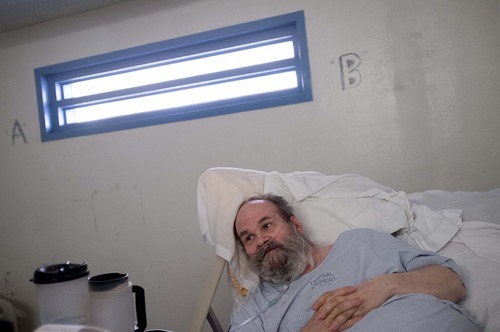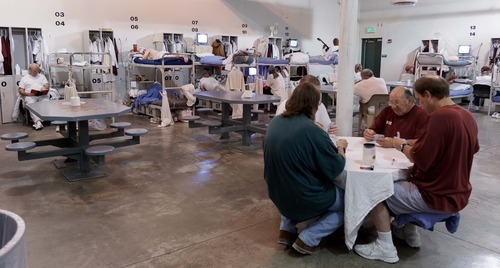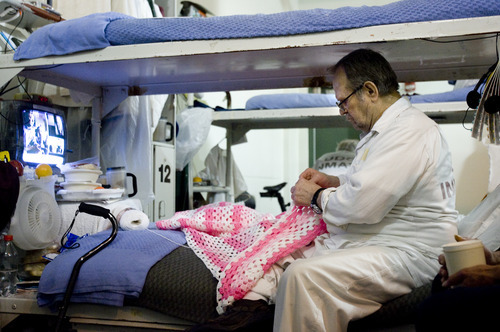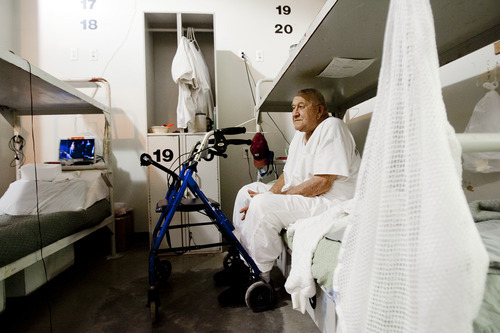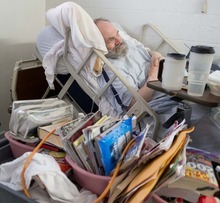This is an archived article that was published on sltrib.com in 2012, and information in the article may be outdated. It is provided only for personal research purposes and may not be reprinted.
Draper • Lionel M. Nance uses a walker to get around and needs help in and out of the shower, getting his meal trays and medications, doing his laundry and making his bed.
He can't see well, has heart and prostate problems, and doesn't always remember to fill his oxygen machine with water.
"If he didn't help me, I don't know what I'd do," said Nance, who is 82.
"He" is Gary L. Phillips, 45, an inmate who has looked after Nance since the older man's arrival at the Utah State Prison in January.
Both inmates are housed in a special geriatric unit at the Lone Peak minimum security facility that was set up about two years ago to accommodate the state's growing number of aging prisoners. The unit is one of two in Utah's corrections system that relies on younger inmates to assist older prisoners with daily living activities.
As in the rest of society, prison populations across the country are getting older, a phenomenon Human Rights Watch calls a "silver tsunami" because of the hard-hitting impact aging inmates are likely to have on state budgets within the coming decade. One study predicts that if older prisoners currently incarcerated remain in prison, the number of inmates ages 65 and older will increase tenfold in the next decade.
In Utah, that age wave is already rolling. There are 619 prison inmates — 9 percent of the state's total prison population — who are older than 55 — the age at which Utah considers an inmate to be "old."
"You age faster when you live the kind of lifestyle that leads to incarceration," Tom Patterson, Corrections director, recently told a legislative interim committee.
But the prison also has a growing number of inmates considered senior citizens by any standard. There are 91 inmates who are ages 70 and older — including one who is 95 years old. The ranks of inmates in this age category tripled over the past 10 years.
What is driving the numbers, according to a January 2012 report by Human Rights Watch, are tough-on-crime policies that have increased the likelihood and length of sentences, particularly for violent crimes and sex offenses; more life and life without parole terms; harsh consequences for parole violations; and the older age of some first-time offenders.
Utah's oldest inmates fit that profile; most are serving long sentences for sex offenses.
Needs, costs higher for older inmates
Aging inmates present a variety of challenges for prison systems. A majority of these prisoners have at least one disability. Like Nance, many need help with daily activities — dressing, eating, and getting to the bathroom. Many can't see or hear well, and some need a cane, walker or wheelchair to get around.
Because of physical limitations, most older inmates require lower-level bunks and may need extra clothing or bedding because of incontinence issues and an inability to tolerate cold temperatures. They also may have trouble participating in recreational, vocational and work programs that are the backbone of routine prison life.
In response to the inmate age wave, at least 13 states have created specialized geriatric units since 2008, according to one national survey. Another six states have created dedicated facilities for older inmates. Nine states have specialized medical facilities that take aging inmates, five had secure nursing home facilities and eight had dedicated hospice units. Several states are looking at creating special nursing homes for ex-felons since many community-based businesses won't accept them, according to Human Rights Watch.
The Lone Peak geriatric unit, which is set up as a 30-bed dormitory that meets Americans with Disabilities Act standards, is Utah's most recent response to the growing ranks of older inmates. The prison also has a similar unit for older inmates within its Oquirrh facility in Draper; older inmates must require minimally hands-on care to be in the units. Officials place inmates who need more intensive, 24-hour nursing care — either because of physical or hygiene problems or dementia — at the Olympus mental health facility; there are currently 34 inmates there who are ages 55 or older. Three inmates are housed at the infirmary, where they are receiving long-term hospice care.
Michelle Buswell, Utah State Prison nursing director, said ambitious plans for the Lone Peak unit, such as having an assigned nursing staff, had to be scaled back due to lack of funds even as the need for specialized care has continued to grow. In mid-July, there were 122 inmates eligible for geriatric units, but no beds available to accommodate them.
"We're in a bed crunch here, trying to put inmates in the right places," Buswell said. "We do the best we can to provide services to them in housing where they are."
But, she added, "This is truly one of the areas we need to look at and how we are going to fund it."
Medical costs incurred by older inmates are significant, and the burden on the state is heavy since inmates are ineligible for Medicaid or Medicare and few have private insurance. One study cited by Human Rights Watch found health care expenses for older inmates were three to nine times higher. The Utah Department of Corrections last tried to calculate medical costs of older inmates in 2004 and came up with an estimate that they were 12 times more expensive than regular inmates, said spokesman Steve Gehrke.
"This population is who uses the majority of our dollars, so our best effort is preventative care," Buswell said. "We try to head off problems early so we don't get chronic illnesses."
Younger inmates assist the aged
At the Lone Peak geriatric unit, half the beds are for younger inmates — called ADA workers — who assist elderly or disabled prisoners or help manage the unit. Inmates are carefully screened to ensure they have the right temperament to be an aide. The job pays $1 an hour.
"It's like a 24-hour job, but it's cool," said Garrick K. Bradshaw, 52, the lead ADA worker at the Lone Peak unit, who is serving time for robbery. "It's cool because you get to know people and bond with them. ... Having a job like this is giving back for all the things you've done in your life."
Despite the around-the-clock duty, there is one upside: "We don't have to worry about being laid off like the other [prison] crews," said Nance's aide, Phillips, who is serving time for credit card fraud.
Larry Beck began assisting 79-year-old Ray Fehr, who has early stage dementia, about six years ago; they moved together to the Lone Peak unit when it first opened. The role came naturally to Beck, who had cared for a family member before being sentenced to prison in 1998 for child sex crimes.
Fehr, also convicted of child sex crimes, has trouble remembering things and gets ornery at times, said Beck, who helps him dress, get in and out of the shower, and with other activities. He also makes sure Fehr spends time in the small recreation yard most days.
"These older fellows, when they get exercise and some sun they get to sleep easier and are less cranky," Beck said.
Every inmate is supposed to work — there is no retirement age in prison — and that presents another challenge when it comes to the oldest felons.
"They're expected to be busy," said Lt. Daniel Sparks, who oversees the Lone Peak facility. That said, "We're not going to give those guys backbreaking work."
Instead, many fulfill work duty in the "Happy Factory," putting together and painting simple wooden cars donated to the prison and sent to needy children.
Some inmates prefer to remain part of the general population as they age, remaining in their "home," so to speak.
"We don't force them to come over," said Sparks.
But many older inmates like the geriatric units because they are quieter, there is less strife and they are less apt to be exposed to violence or manipulation. Nance said he was "miserable" during his brief stay in the general population at the Uinta facility.
"There were too many people talking like magpies up there," said Nance, who is serving a three-years to life sentence for attempted aggravated sexual abuse of a child. "I wanted to get out of there as soon as possible."
Robert D. Lindsey, 81, has been incarcerated since 1998 for child sex crimes and moved to the Lone Peak unit about five months ago. Given his 10-to-life sentence, he expects to spend the rest of his life here.
"I have no objection. I deserve what I got," said Lindsey.
He passes the time watching television and knitting scarves for people who "ain't got nothing." He's had four major operations since being incarcerated in 1998 and, after taking a few falls, now uses a cane to get around. His wife died six years ago. He earns about $15 a month working in the Happy Factory.
"I have nobody outside," Lindsey said. "If I was to need anything, the people here know my age and everything, and these guys make sure I get it."
Compassionate releases are rare
At least 15 states have responded to the "silver tsunami" by adopting "geriatric release" statutes, according to a 2010 report by the Center on Sentencing and Corrections. The statutes allow compassionate release for inmates after evaluating age, medical condition, and risk to public safety. Most require inmates to be at least 60 before they are eligible for such reviews.
The center found, however, that such releases rarely happen. In Colorado, for example, just three prisoners were released under that state's guidelines between 2001 and 2008.
Why? Any cost savings are outweighed by politics and public sentiment, the center said.
The Utah Board of Pardons grants about four to six compassionate release requests per year, based on medical reasons, under a "special attention" hearing rule, said spokesman Jim Hatch. Any inmate, even those with life sentences, can request such a hearing, but the criteria they have to meet are rigorous.
"When these are considered we get a medical report from the prison which contains diagnosis information, placement options, and an explanation about how the offender's medical expenses will be covered," Hatch said. "We don't release geriatric inmates just because they get old. There has to be an underlying medical component."
Lt. Kent DeMill, the officer who oversees the prison's infirmary and the three inmates receiving long-term care there, said he doesn't recall any compassionate releases occurring during the first half of his 25-year career, but there have been about five in the past few years, he said.
Among the inmates housed at the infirmary: Kent Shurtleff Larson, who is 66 and bedridden because of multiple sclerosis.
The disease had already taken firm hold of Larson when he came to prison in 2001 on multiple convictions, including two 15-to-life sentences for child sex crimes. Back then, he could walk only 25 steps before his legs gave out. He has been unable to walk for about two years.
Larson, who will get a parole hearing in 2015, is now serving his time in a two-bed, white-washed cinder block room at the back of the infirmary. For his safety, only an equally incapacitated inmate can be assigned to the room; his previous roommate left the prison a few weeks ago and moved straight into a nursing home. For now, that other bed is empty.
Larson is hooked up to an oxygen tank and a catheter. His personal possessions — books and magazines, a magnetic chess set — are loaded on a two-shelf metal cart within arm's reach. A radio is tucked next to him. He reads a lot, listens to the radio, and writes letters to his wife, who "doesn't condone what I did but she does love me."
Mostly, he relives memories of better times.
"It's like a monastery, only better conditions," Larson said. "I wouldn't be alive if I was on the outside. I couldn't afford the medicine. … I've come close to dying a couple times in here, so I'm grateful for each extra day."
Brooke@sltrib.comTwitter: @Brooke4Trib


